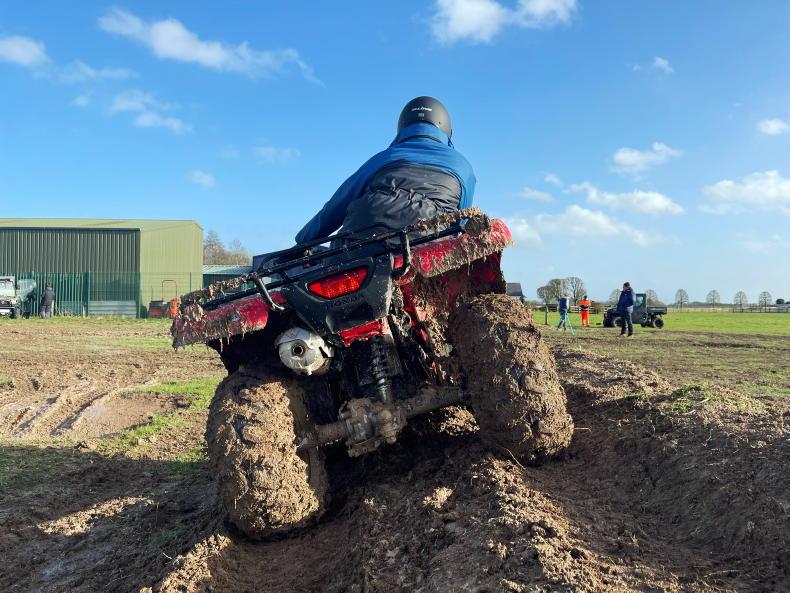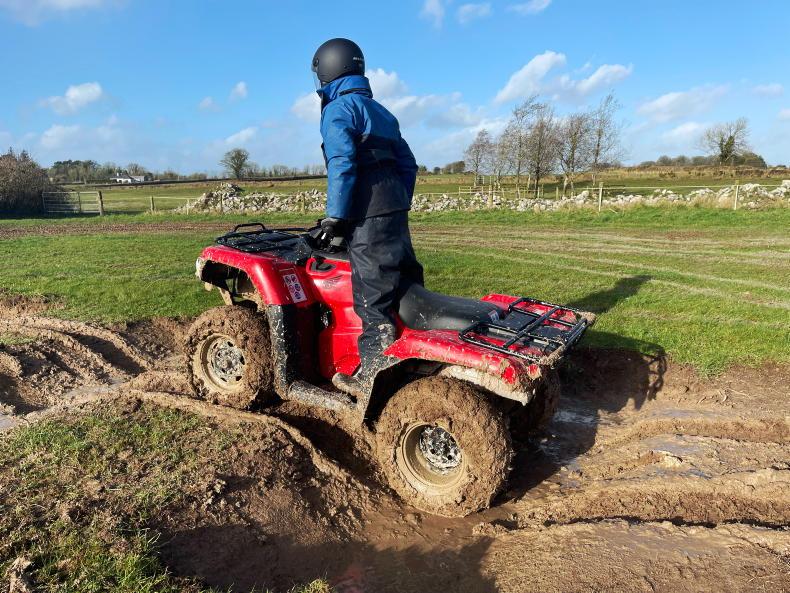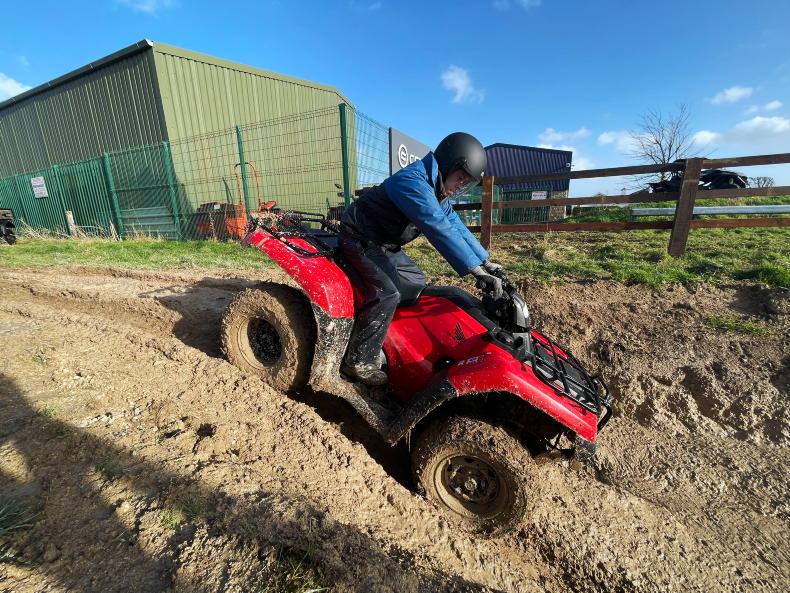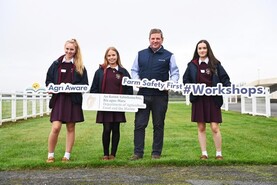Since the beginning of their existence, it was acceptable to operate quads or all-terrain vehicles (ATVs) on farm or within a workplace without having completed a recognised ATV training course. However, this is all about to change in less than a month, as new regulations come into force on the 20 November 2023 (SI NO. 619/2021). From this date on, all personnel operating a quad bike/ATV within a work space must undergo training and hold a valid ATV Safety Training Certificate, provided by a registered training provider to a QQI standard or equivalent. The use of a helmet to a prescribed standard also falls under the incoming regulation.
The introduction of such is one that has been recommended by the Farm Safety Task Force for a number of years now and will position Ireland as the first EU country to introduce a regulation of this kind.
Compliance with any regulation is mandatory from the date of introduction. Therefore, if not already done, all farms with a quad need to consider the necessary measures in order to comply. Note that such regulations apply to all quads, old or new and all operators, not just the owner. According to the Health and Safety Authority (HSA), enforcement of the new regulation will be enforced through on farm inspections.
So what does this mean?
Effectively, where there is an ATV(s) present on-farm or within a work place, then all staff that intend on continuing to operate it must successfully complete an ATV safety training course, which has been provided by a registered training provider to a QQI standard or equivalent.
Regulations also require that a ‘risk assessment is conducted in accordance with section 19 of the Act’. The risk assessment requirement refers to the Safety, Health and Welfare at Work Act, 2005.
The regulation also states that Personal Protective Equipment (PPE) is provided and worn by the operator of the ATV in accordance to Regulation 62. Regulation 62 refers to the personal protective equipment requirements of Safety, Health and Welfare at Work Regulations 2007.
What does training
involve?
The majority of courses tend to last for one full day in duration for experienced operators and up to two days for inexperienced operators. It is important to seek confirmation from the provider first that the training provided will be of QQI standard, or its equivalent, in order to qualify. On average, pricing per person for experienced operators is ranging from €250 to €300, while some providers are offering group discounts.
Upon completion of training, candidates will undergo a practical assessment (60%) and formal questioning in written or verbal form (40%). Successful candidates will receive a Level 5 minor award in All Terrain Vehicle Operations (5N1752). In most cases this certificate will remain valid for five years.
As expected, as part of the training there are a number of learning objectives/ subjects to help equip the operator with the knowledge required to safely operate and maintain any ATV.
The majority of objectives fall under the headings outlined on the next page.
Machine knowledge and pre-start checks
Like any machine, it is important that an ATV is well maintained. Before operating, all riders must have an acceptable understanding of an ATV, its purpose, key components, capabilities, legalities, limitations and pre-start/daily checks as recommended by the manufacturer, etc.
Operators should be able to identify and interpret the major controls and components. As boring as it sounds, the user manual is the best starting point to learn about your specific machine.
Other important information, such as capacities, tend to be displayed on safety decals on the ATV.
Examples of pre-start checks include fully functional brakes, hand brake, suspension, tyre condition and equal inflation pressures, as recommended by the tyre manufacturer. All lights should be operational and all switch gear checked for full functionality, ie ignition, 4WD, engine kill switch, etc.
Operators will also need to be familiar with the checking of fluid levels, such as engine oil and fuel.

Operator mobility forms an integral part of the training.
Safe procedures and observations
Within this topic, everything, including route planning, correct mounting and dismounting procedures to operator weight distribution, will be demonstrated. Safe starting/stopping as well as the correct manoeuvring procedure while riding on flat, rolling or hilly terrain will be covered.
Operator mobility is a key topic of discussion when it comes to the safe use procedure. One must be capable of moving their body weight on the fly in order to maintain stability. For example, when travelling downhill, the operator must lean back to increase stability and vice versa when travelling uphill. When turning right, the operator must lean to the right and when turning left they must lean to the left, all while keeping both feet grounded on the foot pegs. Weight and ground conditions will play a huge factor on stability and control.

The positioning of ones body has a serious impact on the balance and performance of an ATV.
Cargo racks and towing capacity
Understanding ATV loading capacities and their respective limitations is another element of the training. Operators must be able to establish and understand front and rear cargo rack weight limits.
These weights will generally be displayed on the ATV’s body panels and are typically in the region of 45-50kg front and 85-95kg on the rear, but can vary between manufacturers. For example, a 100l sprayer will likely exceed the rear capacities of most ATVs.
While capable of doing so, it is classed as overloading and will severely affect the ATV’s handling.
Operators must be able to establish towing capacities and the importance of adhering to these limits.
Nearly all ATVs will tow over and above their rated towing capacity.
However, this will seriously affect the handling and braking capabilities.

ATVs have a long seat to aid the distribution of operator weight and not for carrying passengers.
The course specification outlines that upon completion all participants must be able to:
1. Outline the role and uses of ATV’s within land based industries.2. Interpret legal requirements pertaining to the use of an ATV and ancillary equipment in an off-road situation and on public roads. 3. Outline the need for safe and efficient ATV operation to maximise stability on flat, rolling and hilly terrain. 4. Interpret safety decals, controls and instrument panels for an ATV appropriate to work situation involved.5. Carry out routine pre-starting checks specified in the operator’s manual. 6. Drive an ATV around a specified course in a controlled manner appropriate to the terrain and surface conditions. 7. Operate an ATV effectively and in accordance with safety requirements.8. Operate an ATV effectively with ancillary equipment for a range of tractor tasks.
Helmets were grant eligible up to 60% under the National Farm Safety Measure 2023.
As part of the incoming regulation, the wearing of PPE is also mandatory. Helmets, as the major requirement, have been eligible for grant aid up until now under the new National Farm Safety Measure 2023. However, claims for payment must be submitted through www.AgFood.ie before Friday 27 October. For those who missed out on the grant and still need to purchase a helmet, it is advised to buy a helmet that is ECE 22.05 or ECE 22.06 certified.
1. Where can I avail of training?
If unsure as to where you can avail of training, you can contact QQI, Lantra or City&Guilds for information on approved ATV trainers in your area. FRS training is one example of an approved provider.2. How much can I expect to pay for training?
Pricing for experienced operators tends to range from €250 to €300 per person. 3. How long is the training course?
Typically, training lasts one day for experienced operators and two days for inexperienced operators. 4. Is there an assessment or exam afterwards?
Once the operator has successfully completed the training, they will be assessed by the coordinator and marked based on the relevant criteria in relation to the objectives outlined. Successful candidates will then receive their certificate. 5. Is the assessment practical or theory based? Practical assessment (60%) and formal questioning in written or verbal form (40%).6. How long is training valid for?
Five years.7. Is there a minimum age for training?
The minimum age in order to operate a quad is 16, so therefore the minimum age for training is 16.8. I own a UTV (Mule, Gator, side by side) do I require training under the new regulation?
No, for now it is just ATV operators that need to undergo mandatory training.9. Where the ATV is operated by numerous people, if one person undergoes the training, will that suffice?
No, every operator is required to undergo training.10. What are classed as typical work spaces?
Farms, construction sites, road maintenance, forestry and other land-based industries are all examples. 11. I own an old ATV which is operated very occasionally, do the rules still apply?
Yes, the regulation applies to all makes, models and ages of ATV once used within a workplace. From 20 November, all riders must wear a helmet and undergo training to obtain a valid level 5 QQI or equivalent ATV Safety Training Certificate. One day courses for experienced operators range between €250 and €300.Training remains valid for five years.Contact QQI or City&Guilds for further information and to find out where your nearest approved ATV trainer is.
Since the beginning of their existence, it was acceptable to operate quads or all-terrain vehicles (ATVs) on farm or within a workplace without having completed a recognised ATV training course. However, this is all about to change in less than a month, as new regulations come into force on the 20 November 2023 (SI NO. 619/2021). From this date on, all personnel operating a quad bike/ATV within a work space must undergo training and hold a valid ATV Safety Training Certificate, provided by a registered training provider to a QQI standard or equivalent. The use of a helmet to a prescribed standard also falls under the incoming regulation.
The introduction of such is one that has been recommended by the Farm Safety Task Force for a number of years now and will position Ireland as the first EU country to introduce a regulation of this kind.
Compliance with any regulation is mandatory from the date of introduction. Therefore, if not already done, all farms with a quad need to consider the necessary measures in order to comply. Note that such regulations apply to all quads, old or new and all operators, not just the owner. According to the Health and Safety Authority (HSA), enforcement of the new regulation will be enforced through on farm inspections.
So what does this mean?
Effectively, where there is an ATV(s) present on-farm or within a work place, then all staff that intend on continuing to operate it must successfully complete an ATV safety training course, which has been provided by a registered training provider to a QQI standard or equivalent.
Regulations also require that a ‘risk assessment is conducted in accordance with section 19 of the Act’. The risk assessment requirement refers to the Safety, Health and Welfare at Work Act, 2005.
The regulation also states that Personal Protective Equipment (PPE) is provided and worn by the operator of the ATV in accordance to Regulation 62. Regulation 62 refers to the personal protective equipment requirements of Safety, Health and Welfare at Work Regulations 2007.
What does training
involve?
The majority of courses tend to last for one full day in duration for experienced operators and up to two days for inexperienced operators. It is important to seek confirmation from the provider first that the training provided will be of QQI standard, or its equivalent, in order to qualify. On average, pricing per person for experienced operators is ranging from €250 to €300, while some providers are offering group discounts.
Upon completion of training, candidates will undergo a practical assessment (60%) and formal questioning in written or verbal form (40%). Successful candidates will receive a Level 5 minor award in All Terrain Vehicle Operations (5N1752). In most cases this certificate will remain valid for five years.
As expected, as part of the training there are a number of learning objectives/ subjects to help equip the operator with the knowledge required to safely operate and maintain any ATV.
The majority of objectives fall under the headings outlined on the next page.
Machine knowledge and pre-start checks
Like any machine, it is important that an ATV is well maintained. Before operating, all riders must have an acceptable understanding of an ATV, its purpose, key components, capabilities, legalities, limitations and pre-start/daily checks as recommended by the manufacturer, etc.
Operators should be able to identify and interpret the major controls and components. As boring as it sounds, the user manual is the best starting point to learn about your specific machine.
Other important information, such as capacities, tend to be displayed on safety decals on the ATV.
Examples of pre-start checks include fully functional brakes, hand brake, suspension, tyre condition and equal inflation pressures, as recommended by the tyre manufacturer. All lights should be operational and all switch gear checked for full functionality, ie ignition, 4WD, engine kill switch, etc.
Operators will also need to be familiar with the checking of fluid levels, such as engine oil and fuel.

Operator mobility forms an integral part of the training.
Safe procedures and observations
Within this topic, everything, including route planning, correct mounting and dismounting procedures to operator weight distribution, will be demonstrated. Safe starting/stopping as well as the correct manoeuvring procedure while riding on flat, rolling or hilly terrain will be covered.
Operator mobility is a key topic of discussion when it comes to the safe use procedure. One must be capable of moving their body weight on the fly in order to maintain stability. For example, when travelling downhill, the operator must lean back to increase stability and vice versa when travelling uphill. When turning right, the operator must lean to the right and when turning left they must lean to the left, all while keeping both feet grounded on the foot pegs. Weight and ground conditions will play a huge factor on stability and control.

The positioning of ones body has a serious impact on the balance and performance of an ATV.
Cargo racks and towing capacity
Understanding ATV loading capacities and their respective limitations is another element of the training. Operators must be able to establish and understand front and rear cargo rack weight limits.
These weights will generally be displayed on the ATV’s body panels and are typically in the region of 45-50kg front and 85-95kg on the rear, but can vary between manufacturers. For example, a 100l sprayer will likely exceed the rear capacities of most ATVs.
While capable of doing so, it is classed as overloading and will severely affect the ATV’s handling.
Operators must be able to establish towing capacities and the importance of adhering to these limits.
Nearly all ATVs will tow over and above their rated towing capacity.
However, this will seriously affect the handling and braking capabilities.

ATVs have a long seat to aid the distribution of operator weight and not for carrying passengers.
The course specification outlines that upon completion all participants must be able to:
1. Outline the role and uses of ATV’s within land based industries.2. Interpret legal requirements pertaining to the use of an ATV and ancillary equipment in an off-road situation and on public roads. 3. Outline the need for safe and efficient ATV operation to maximise stability on flat, rolling and hilly terrain. 4. Interpret safety decals, controls and instrument panels for an ATV appropriate to work situation involved.5. Carry out routine pre-starting checks specified in the operator’s manual. 6. Drive an ATV around a specified course in a controlled manner appropriate to the terrain and surface conditions. 7. Operate an ATV effectively and in accordance with safety requirements.8. Operate an ATV effectively with ancillary equipment for a range of tractor tasks.
Helmets were grant eligible up to 60% under the National Farm Safety Measure 2023.
As part of the incoming regulation, the wearing of PPE is also mandatory. Helmets, as the major requirement, have been eligible for grant aid up until now under the new National Farm Safety Measure 2023. However, claims for payment must be submitted through www.AgFood.ie before Friday 27 October. For those who missed out on the grant and still need to purchase a helmet, it is advised to buy a helmet that is ECE 22.05 or ECE 22.06 certified.
1. Where can I avail of training?
If unsure as to where you can avail of training, you can contact QQI, Lantra or City&Guilds for information on approved ATV trainers in your area. FRS training is one example of an approved provider.2. How much can I expect to pay for training?
Pricing for experienced operators tends to range from €250 to €300 per person. 3. How long is the training course?
Typically, training lasts one day for experienced operators and two days for inexperienced operators. 4. Is there an assessment or exam afterwards?
Once the operator has successfully completed the training, they will be assessed by the coordinator and marked based on the relevant criteria in relation to the objectives outlined. Successful candidates will then receive their certificate. 5. Is the assessment practical or theory based? Practical assessment (60%) and formal questioning in written or verbal form (40%).6. How long is training valid for?
Five years.7. Is there a minimum age for training?
The minimum age in order to operate a quad is 16, so therefore the minimum age for training is 16.8. I own a UTV (Mule, Gator, side by side) do I require training under the new regulation?
No, for now it is just ATV operators that need to undergo mandatory training.9. Where the ATV is operated by numerous people, if one person undergoes the training, will that suffice?
No, every operator is required to undergo training.10. What are classed as typical work spaces?
Farms, construction sites, road maintenance, forestry and other land-based industries are all examples. 11. I own an old ATV which is operated very occasionally, do the rules still apply?
Yes, the regulation applies to all makes, models and ages of ATV once used within a workplace. From 20 November, all riders must wear a helmet and undergo training to obtain a valid level 5 QQI or equivalent ATV Safety Training Certificate. One day courses for experienced operators range between €250 and €300.Training remains valid for five years.Contact QQI or City&Guilds for further information and to find out where your nearest approved ATV trainer is. 









 This is a subscriber-only article
This is a subscriber-only article










SHARING OPTIONS: